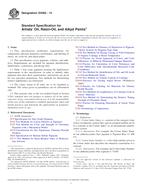We need your consent to use the individual data so that you can see information about your interests, among other things. Click "OK" to give your consent.
ASTM D5326-94a(2013)
Standard Test Method for Color Development in Tinted Latex Paints (Includes all amendments And changes 1/27/2022).
Automatically translated name:
Standard Test Method for Color Development in Tinted Latex Paints
STANDARD published on 1.7.2013
The information about the standard:
Designation standards: ASTM D5326-94a(2013)
Note: WITHDRAWN
Publication date standards: 1.7.2013
SKU: NS-30744
The number of pages: 3
Approximate weight : 9 g (0.02 lbs)
Country: American technical standard
Category: Technical standards ASTM
The category - similar standards:
Annotation of standard text ASTM D5326-94a(2013) :
Keywords:
color, color development, color uniformity, colorants, tintability, ICS Number Code 87.040 (Paints and varnishes)
Additional information
| Significance and Use | ||||||||||||||||||||
|
5.1 A colorant sometimes fails to disperse completely in a base paint due to poor compatibility, which can be the fault of the colorant, the paint, or both. This will result in poor color development, which is readily manifested by the common procedure of applying the paint with a doctor blade and subjecting the drawdown to high shear stress by finger-rubbing a small area of the partially dry film. This tends to disperse undeveloped colorant, if any, and produces a color variation between the unsheared and sheared areas of the paint film. The variation can be measured colorimetrically to give a numerical color difference value that is a measure of the color development of the original paint, the smaller the difference the better the color development and vice versa. Color difference values obtained by finger-rubbing were found to vary widely for the same as well as among different operators. This test method establishes a controlled shear-stress procedure analogous to the finger rub-up test, but with far better reproducibility. 5.2 Poor color development can be a problem in the production of paints, and in their performance in the field. In production it causes a loss of colorant monetary value, and unpredictable tinting results. In field performance it results in color variations in the applied paint film due to the varying shear forces to which the paint is subjected at different stages or by different modes of application. 5.3 Although poor color development is primarily and most often related to the colorant portion of a tinted paint, the white pigment in the base paint can also be poorly developed due to flocculation or other causes. In the latter case, shear dispersion can make the paint film lighter and less colorful, rather than the reverse. Then too, the colorant and the white might both be poorly developed, and the color change due to shear stress would then be the combined effect of both. 5.4 In any case, color development is an important paint property, for the measurement of which this test method is intended to provide a generally accepted and reproducible test method. |
||||||||||||||||||||
| 1. Scope | ||||||||||||||||||||
|
1.1 This test method covers a procedure for measuring color development in tinted latex paints, for the purpose of determining the efficiency of colorants, the tintability of base paints and the potential for poor color uniformity of applied paint films. 1.2 The values stated in inch-pound units are to be regarded as standard. The values given in parentheses are mathematical conversions to SI units that are provided for information only and are not considered standard. 1.3 This standard does not purport to address all of the safety concerns, if any, associated with its use. It is the responsibility of the user of this standard to establish appropriate safety and health practices and determine the applicability of regulatory limitations prior to use. |
||||||||||||||||||||
| 2. Referenced Documents | ||||||||||||||||||||
|
Similar standards:
Historical
1.6.2010
Historical
1.6.2013
Historical
1.7.2012
Historical
1.7.2007
Historical
1.2.2010
Historical
1.7.2014
We recommend:
Technical standards updating
Do you want to make sure you use only the valid technical standards?
We can offer you a solution which will provide you a monthly overview concerning the updating of standards which you use.
Would you like to know more? Look at this page.



 ASTM D4146-10
ASTM D4146-10 ASTM D4147-99(2013)..
ASTM D4147-99(2013).. ASTM D4213-08(2012)..
ASTM D4213-08(2012).. ASTM D4214-07
ASTM D4214-07 ASTM D4287-00(2010)..
ASTM D4287-00(2010).. ASTM D4302-14
ASTM D4302-14
 Cookies
Cookies
